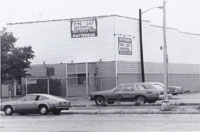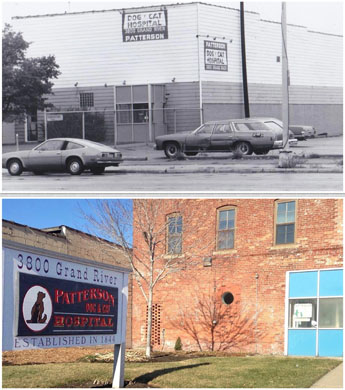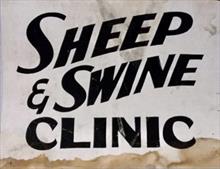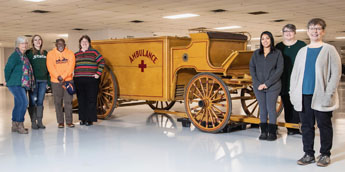Oldest known animal hospital in U.S. dates to horse-and-buggy era

Patterson Dog & Cat Hospital

Top: Patterson Dog & Cat Hospital as it appeared in the 1980s.
Photo courtesy of Patterson Dog & Cat Hospital
Bottom:Patterson Dog & Cat Hospital today. Owner Dr. Glynes Graham proudly describes the 110-year-old building as "solid brick construction, three bricks deep." The 1960s-era baby-blue fiberglass section is due to be replaced soon by a brick-and-glass vestibule with help from a grant from Motor City Re-store.
Photo by Jessica Baile
Dr. Glynes Graham and her staff at Patterson Dog & Cat Hospital thought it was a big deal when their practice turned 150. They threw a party in the hospital's turn-of-the-century brick building, hundreds of people attended and the business received a proclamation from the city recognizing the hospital's historic value.
That was 25 years ago.
This year, Patterson celebrates its 175th anniversary. Graham is still there, as is groomer Robert Thompson, her staffer with the longest tenure. Passing this milestone gives the clinic multiple claims to distinction.
"We are the oldest small business in the city of Detroit that is not either a cemetery or a church," Graham said. Careful not to exaggerate, she added, "There are also a couple of businesses that were established in Detroit that are still going, but they are no longer in the city. We're the oldest business in Detroit that is still in Detroit."
Patterson also is the oldest continuously operating veterinary practice in the United States, according to the Registry of Heritage Veterinary Practices maintained by the American Veterinary Medical History Society. The next-oldest practice on the registry is Hagyard Equine Medical Institute in Kentucky, established in 1876.
During a time of rapid change in the veterinary profession, as rising numbers of practices come under consolidated corporate ownership fueled by private-equity investor dollars, Patterson Dog & Cat Hospital represents a period of greater stability — a stability that holds to this day.
Graham is only the fifth owner of Patterson. She's been connected to the hospital for 44 years, having begun working there at age 15, filing records and cleaning cages. She earned a veterinary degree at Michigan State University in 1983. Two years later, she and her then-husband bought the hospital. Graham is coming up on 34 years as owner. Patterson's groomer, Thompson, is approaching his 40th anniversary with the company this year.
As Graham sees it, Patterson's origin story is intrinsic to the practice. "It was always important to me. It was of interest to Dr. Miller, and it was information that he shared," she said, referring to Dr. Eugene Miller, who owned the practice before her. "We didn't have to hunt and dig to find out what had happened."
The story goes like this: The clinic was founded in 1844 by Dr. James William Patterson, a veterinarian who moved from England to Detroit, where he opened a large animal practice downtown, becoming the city's only veterinarian, according to a 2008 account in DVM360.
Sheep & Swine Clinic

Photo by Amanda Walz
This sign is one of a few relics found on the premises of Patterson Dog & Cat Hospital.
His son, Elijah Patterson, also became a veterinarian. The younger Patterson moved the hospital in 1909 to its present location — today, an historic neighborhood of mostly Victorian homes, called Woodbridge. The practice during the early 1900s focused on equines, reflecting a time when horses were essential for transportation and farming.
But the invention of the automobile, followed by Henry Ford's introduction in 1908 of the mass-produced Model T, started a revolution in transportation — and by extension, in veterinary practice. Responding to the change, Patterson hospital was remodeled in 1926 to serve small animals.
The practice passed to a third Patterson, Elijah's son James. He stayed until 1966, when he sold the business to Miller. That brings us to Graham. She worked for Miller part-time while in high school and during summers as a college student.
Graham married a fellow student immediately after graduating veterinary school. The couple moved to West Virginia. During a Christmas visit home to Detroit, Graham stopped by the clinic to say hello to her mentor, Miller. He told her, "I'm on my way to sign the papers to sell to Dr. Dworkis."
A veterinarian in Michigan, Dr. Andrew Dworkis was an early consolidator, founding a chain of hospitals called Professional Veterinary Hospitals, also known as PVH. Graham said Miller wasn't keen on selling to Dworkis but Detroit was in a slump, so no one else was interested in buying the place.
Dr. Glynes Graham

Photo courtesy of Dr. Glynes Graham
Shown in her veterinary school graduation photo in 1983, Dr. Glynes Graham started working at Patterson hospital at age 15.
Except Graham. She asked her old boss to hold off on the deal with Dworkis.
"Give me 24 hours," she said.
"I called my husband," she recounted, "and I said, 'Pack your shit. We're coming back to Detroit and buying Patterson.' "
The opportunity thrilled her. "I never wanted to leave Detroit," Graham told the VIN News Service. "... but I did because I was in love and I got married, so off we went."
Her husband had been negotiating with a veterinarian in West Virginia to buy a practice, but the owner of that practice "was just stringing him out," she said. So he agreed to buy Patterson with her.
In the end, the marriage didn't survive. The couple divorced in 1989 and Graham bought out her ex's share of the business in 1991. She's been the sole owner since, and works mainly solo. She has a staff of eight and the help of a relief veterinarian who works a couple of days a week.
Someone once asked Graham if she ever thought about changing the name of the practice. "Are you crazy?" Graham replied. "Why would I give up that name? Why would I give up a name that is over 100 years old?"
Just as the hospital was in the Patterson family for generations, many clients are from families that have taken their animals there for generations.
Ambulance

Photo by Larry Peplin
The Patterson team visited the Henry Ford Museum recently to see the ambulance used by Dr. Elijah Patterson, the hospital's second owner. The horse-drawn vehicle, Detroit's first ambulance, transported horse patients.
Shown from left are: Lynda Felix, Krysta Castiglione, Robert Thompson, Cynthia Kalicki, Reina Algabri, Amanda Walz and Dr. Glynes Graham.
Click here for a larger view
"We get people coming in who say, 'Oh, my grandmother used to come in here when I was a little kid,' " said hospital manager Amanda Walz.
Graham said the first ambulance ever to operate in Detroit was built by Dr. Elijah Patterson to carry sick horses. He later donated the vehicle to the Henry Ford Museum, located in Dearborn, a Detroit suburb.
The transition from horse power to internal-combustion engine is vivid in Graham's memory — not that she was alive back then, but she knew people who knew people who were. "One of my Sunday school teachers, when I was a little girl, said her father always complained about Henry Ford and his noisy machine," she said.
Exactly what date Patterson veterinary hospital was founded is lost to the past. All today's Patterson crew knows is the year, 1844. Graham and team have selected July 20 as their day to celebrate.
"We're having a little fair with horses and chickens, stuff like that," Graham said, "so it's kind of like [we're] the original Pattersons."